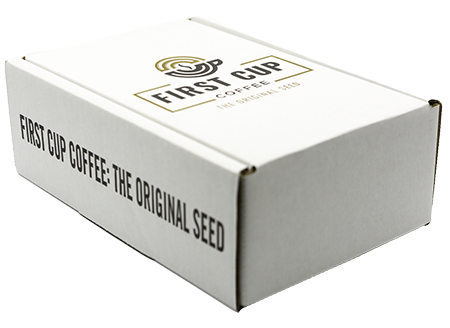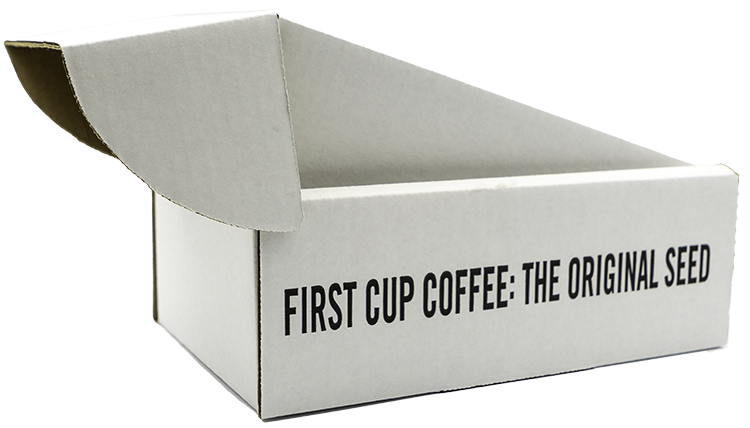WE ARE DEDICATED TO FULFILLING ALL YOUR PACKAGING NEEDS WITH EXCEPTIONAL SERVICE
Custom-printed packaging for online order fulfillment
Case study
First Cup Coffee: The Original Seed.
This mail-order coffee company specializing in single-origin Ethiopian coffee turned to Brown & Pratt to meet their shipping and packaging needs.
Case Study highlights
Custom-Printed Packaging to Extend Branding.
01. Collaboration
Working with startup companies to meet their unique needs.
02. Packaging Specs
Getting the specs right is critical and requires attention to detail.
03. Flexibility
Even clients who know what they want need education and guidance.
04. Learning
Handling mistakes to maintain client relationships.
Collaboration
Working with Startup Companies
Modern Startup Companies have Unique Needs and Goals
There was a clear vision for a deluxe mailer box despite the higher up-front tooling costs required to make the cutting dies.
First Cup Coffee: The Original Seed is a coffee roasting company specializing in single original Ethiopian coffee that it sells online. Products are available as whole bean, five different grinds, and in coffee pods. When the company approached Brown & Pratt about custom-printed packaging, they knew from the beginning what they wanted, which is increasingly common with startup companies and younger founders. They are more familiar with the rise of unboxing and tend to have a clearer picture of exactly what they want early on. In this case, First Cup Coffee had a clear vision for a deluxe mailer box despite the higher up-front tooling costs required to make the cutting dies.
Being coffee people, the client had likely done their own research to see how other companies were doing their packaging, which is why the client knew what they wanted. Their goal was to not appear like a startup but instead look like they were already established with a smart-looking mailer box most rookies wouldn’t have figured out in the startup phase. In other words, the modern startup doesn’t want anything to look like they’re inexperienced because it could turn customers off by creating doubt about the quality of the product. This is how important even packaging is in shaping customer perceptions of the company’s brand and products. Having the product arrive to a customer’s doorstep in a plain brown box simply wouldn’t have the desired branding and product quality impact.
The takeaway here is that consumers can and will form an initial impression about a product’s quality based on the packaging it comes in.
Packaging Specs
Deluxe Mailer Boxes for Online Order Fulfillment and Shipping
Triple-Check Everything to Avoid Potentially Costly Mistakes
The custom printing for the mailer box was relatively simple with just two colors (brown and black), a simple company logo, and the full company name printed on the sides of the box. Getting the specs right on the box itself, however, proved a bit more challenging. The client wanted a deluxe mailer box, white on the outside, kraft brown on the inside, with a “rollover front tuck”, in which the lip, rather than tucking down inside the box (tuck top mailer box), rolls over the front and is secured with tabs that fit into slots on the front of the box.
Brown & Pratt designers created the prototype box but didn’t get the orientation right on the first try. Nearly every mailer box when lying flat on a table in front of the customer would be horizontally wider than the vertical height, similar to the difference between “landscape” versus “portrait” orientation of photographs or a word processing document. But this client wanted the opposite orientation, which is rare for this type of mailer box. When you think of the shape of a standard bag of coffee, the client wanted the bag to fit in the box such that when the box is opened, you’re looking at the front of the bag of coffee in a vertical or portrait orientation. They wanted the customer to immediately read what’s on the front of the coffee bag without having to turn the box. Because nearly all mailer boxes are created with a “landscape” orientation, the designers incorrectly assumed this box would be oriented that way.
Luckily, the client was patient in waiting for Brown & Pratt to redesign the box to get the orientation right. Then, there was almost another big misstep, which would have been a costly one had it not been noticed. On the verge of sending the final PDF proof of the artwork ahead of beginning a production run, the Brown & Pratt account manager for the client realized that the way the artwork was laid out on the box shape would result in the side-panel company name text being upside down! It’s hard to notice these sorts of things on a two-dimensional proof when the artwork is laid out onto a shape matching the flat box that has not yet been assembled. If the printing plates had been tooled and the initial production engaged, the customer would have ended up with 1,000 incorrectly printed boxes. Brown & Pratt would have had to re-tool the printing plates, which is a nightmare scenario due to the tooling costs involved.
The good news in this case study is that the client was very pleased with how the deluxe mailer box turned out. In fact, the client later decided they also wanted custom-printed tape to use for sealing purposes.
There was almost a big misstep, which would have been a costly one had it not been noticed. The Brown & Pratt account manager realized that the way the artwork was laid out on the box shape would result in the side-panel company name text being upside down!

flexibility
Meeting Clients Where They’re At
Check Your Assumptions About What a Client Does and Doesn’t Know
Every client will still need education and guidance along the way.
When a client comes along who has a very clear vision of what they want and can articulate it in detail, it’s easy to assume the client knows more than they do about custom-printed packaging. Those assumptions must be checked to ensure you are meeting the client where they’re at. A client may appear to know more than they really do.
As this project developed with the client, it became apparent there were some misconceptions to correct. For example, the client was assuming his boxes would involve printing in three colors, including the brown and black artwork and the white on the outside of the box. The client didn’t realize the cardboard would come with one side already being white (the outside of the mailer box) and the other side brown kraft (the inside of the box). The client had the same misconception about the custom-printed sealing tape as well. In both cases, each job was only a two-color job, in one case printed on the white side of the corrugated mailer box and in the other case printed on white carton sealing tape. The client was pleased to discover the lower costs involved with two-color printing versus three-color printing.
The point here was that every client, regardless of how knowledgeable they appear to be at first, will still need education and guidance along the way. The vendor must stay tuned to pick up on those places where education or guidance is needed rather than assuming a client must know based on their initial clarity about what they want.
Learning
Avoid Mistakes, but Own Them When They Happen
How Mistakes are Handled Impacts Client Retention
Repairing and maintaining the relationship with a client is of the utmost importance.
Missteps and mistakes are always possible, and when they do occur, it could completely derail the relationship with a client, causing them to switch to a new vendor. Brown & Pratt’s reputation is such that we’re often the vendor a customer is switching to because of a bad experience with another vendor.
This is especially true when clients have tried to work directly with manufacturers that have made online ordering of packaging products “easy” by letting them select their packaging template and upload artwork themselves. The problem with this approach is that most clients have never done this self-design process before, which means the chances are much higher for the final product not to turn out right because the client simply didn’t know how to check things over. They end up with a pile of packaging that’s wrong and must eat the cost of their own mistakes. It’s also been our experience with those kinds of vendors that while the up-front setup costs appear to be the cheapest, the per-unit cost of each box ends up being significantly more than with Brown & Pratt, sometimes as much as four times more.
The advantage of working with a full-service packaging company like Brown & Pratt is avoiding those kinds of costly mistakes because it’s their job to make sure everything’s right. Yes, the occasional mistake still occurs, but Brown & Pratt is going to address it and make it right! Repairing and maintaining the relationship with a client is of the utmost importance, which may or may not be the case with other vendors.


Brown & Pratt: Your Custom Printed Packaging Partner
When you need shipping and packaging solutions that extend and reinforce your company’s brand, Brown & Pratt is ready to help with custom-printed boxes, bags, tape, and more.
Find Out More

